January 25, 2019
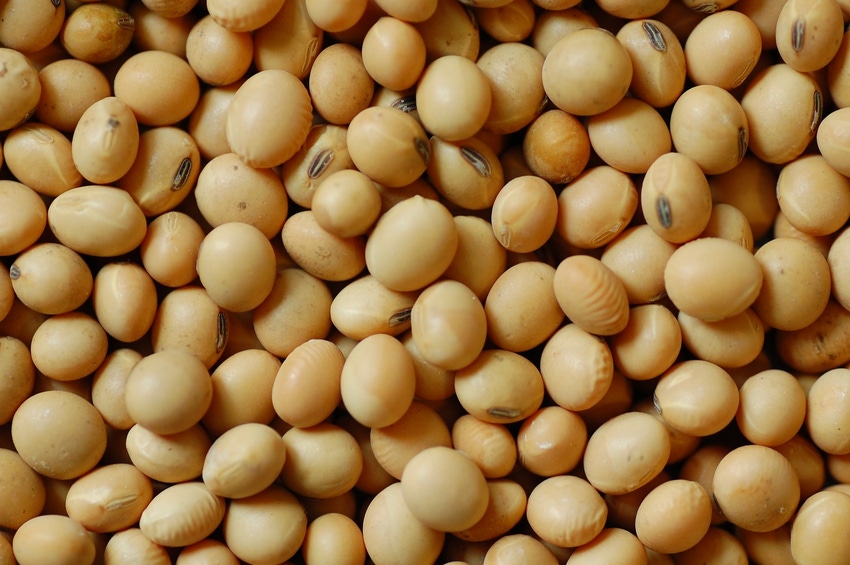
Note that the typical planting date is the average planting date in farmer’s fields (since trial planting dates are similar to farmers planting dates), while optimum planting date is the date that planting would have resulted in highest yield (based on our analysis).
Introduction
The U.S. is a major soybean producing country that supplies 34% of global annual soybean production. Most U.S. soybean-producing regions are rainfed, and thus are highly vulnerable to extreme weather events. Drought and elevated air temperatures, now more increasingly frequent due to climate change, are important constraints in crop production across major agricultural areas globally. Thus, the challenge to increase crop yields to meet future demand can be achieved by increasing the rate at which climate change adaptation practices are identified and adopted. Vapor pressure deficit (Vpd) is a measure of atmospheric water demand with a strong influence on plant transpiratory water loss(Lobell et al., 2013). Increasing Vpd values are generally associated with drought and heat. Improved genetic traits and crop management strategies could help mitigate the projected negative impacts of climate change on crop yields.
For example, drought-tolerant traits, introduced through conventional breeding, resulted in soybean transpiration rates that plateaued at Vpd levels above 1.4-2.1 kPa (Devi et al., 2014). Crop management strategies, such as earlier-than-typical planting, has also been proposed as a strategy to increase yields in regional studies (Rattalino Edreira et al., 2017).
However, soybean exhibits different sensitivities to weather during varied developmental stages (Purcell and Specht, 2004), and therefore, the sensitivity of a crop to climate adaptation strategies and their effectiveness in mitigating drought-induced yield reduction remains unclear. An important step towards adapting to climate change and mitigating its impact on yield is accurate identification of the weather conditions that most affect crop yield. 2 As has been reported earlier, one option is planting date adjustment. Regional trials have shown the benefits of earlier planting (Rattalino Edreira et al., 2017); however, there is a limit to how much the regional field trials can extrapolate results. Our objective was to examine crop sensitivity to varying in-season weather conditions and to model optimal planting dates and associated yield and monetary benefits due to planting date adjustment across the U.S. To date, there is no similar previous work.
Materials and Methods
We used data from soybean seed yield cultivar trials performed by agricultural university personnel in 27 states during 2007–2016 (Fig. 1). These multiple-site trials were conducted each year (n=1,323 location × year yield data) in representative soybean production areas. Within each state, the trial planting date data bracketed the 50% planting date progress reported by USDA-NASS for each state and year. These 27 states accounted for ~99% of total U.S. soybean cultivated area (2007–2016 average). The 1,323 location × year yield data were aligned with 1-K-resolution daily weather data. State-wide average yield and weather conditions were calculated resulting in 186 state-year soybean yield and weather condition data.
Figure 1. Soybean area distribution in the U.S. Circles show the locations of the rainfed soybean yield cultivar trials conducted during 2007-2016 in 27 states (n=1,323 location × year combinations), and the yellow-to-brown coloration denotes relative soybean crop density. Location-specific (A) and state-wide (B) average cultivar trial sowing dates expressed as day of year (DOY) across the U.S. from 2007–2016 (see chart below for corresponding calendar date).
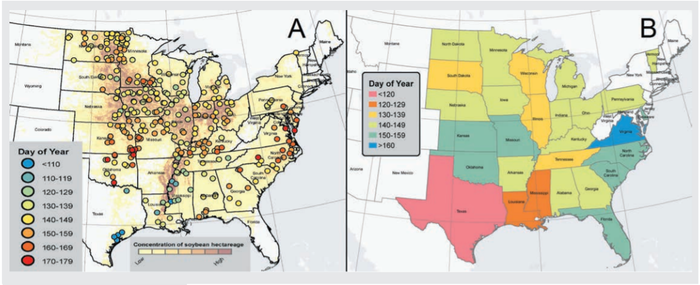
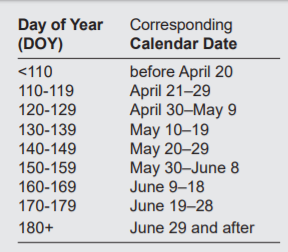
To identify weather variables during the growing season that had the strongest impact on soybean seed yield in the 10-year, 27-state data set, we used conditional inference regression tree analyses (Fig. 2). Our chosen candidate predictors were: the state in which a trial was performed, cumulative precipitation and solar radiation, average Vpd, maximum temperatures, and relative humidity. We divided the growing season into six successive 30-day time windows from 30 days before planting (DBP) to 150 days after planting (DAP), and calculated predictor values for each window, thereby resulting in 31 total candidate weather predictors.
Machine learning regression analysis, utilizing coordinates and the aforementioned 30-day-specific and season-wide variables to capture differential weather sensitivities at different development stages and season-wide weather variables, was used to predict the yet to be observed soybean yields. Then, for all locations and years in the study, seven different weather datasets were created by changing planting date from -30 to +30 days from typical (average) in 10-day increments. The machine learning model was applied then in all weather datasets to simulate soybean yield in each location from 2007 through 2016 for a total of 1,890 simulations. The simulated yields were fitted in a multilevel model to quantify the effect of variable planting date on soybean yield.
Figure 2. Conditional inference tree for 186 U.S. state-year soybean trial yields (bu/ac) distributed across 27 states during 2007-2016 (Fig. 1). In each boxplot, the central rectangle spans the first to third yield quartiles. The solid line inside the rectangle is the mean which is also numerically shown at the bottom (Y). The number of state-year yields (total=186) is shown on top of each boxplot (n). The white circles show outlier yields. The acronyms DAP, DBP, and Vpd are, respectively, days after planting, days before planting, and vapor pressure deficit, with Vpd reported in kPa and precipitation in inches. States in group 1 include: AL, FL, GA, IA, KS, LA, MN, MO, NC, ND, OK, TN, TX, and VA. States in group 2 include: AR, DE, IL, IN, KY, MI, MS, NE, OH, PA, SD, SC, and WI. States in group 3 include: AL, GA, ND, OK, and TX. States in group 4 include: FL, IA, KS, LA, MN, MO, NC, TN, and VA.
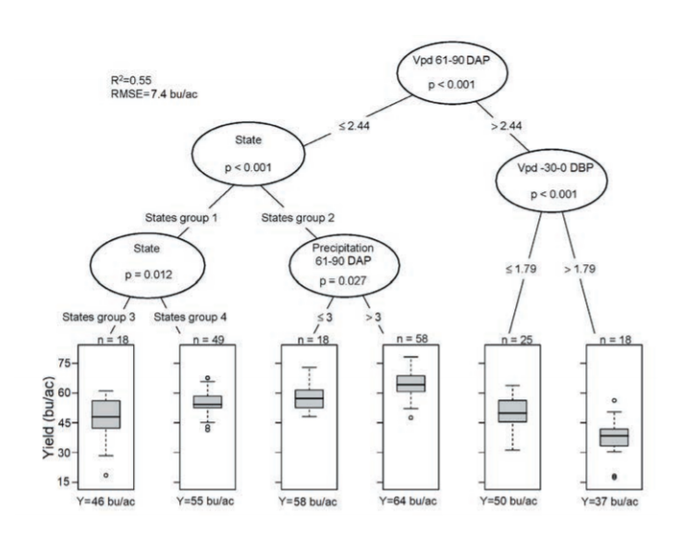
The monetary effect of optimum planting was calculated by considering the percentage of yield change due to optimum planting within each state, and the total state-wide non-irrigated soybean production change in each year (2007 to 2016). Then, the estimated state-year-specific total income ($) was adjusted for inflation to 2016 U.S.$ values. Finally, frost probabilities were calculated using binomial distribution of event occurrence (spring frost vs. no frost) for different daily minimum temperature thresholds in all locations of the study (n=289 locations distributed in 27 states). The last 46 years of weather data (1981–2016) for each location were used to calculate the probabilities.
Results and Discussion
The conditional inference tree analyses revealed that Vpd during 61–90 DAP was the most important predictor of soybean yield (Fig. 2), which was consistent with a finding in a previous study that focused on just three Midwestern states(Lobell et al., 2014). The lowest trial yields were observed in state-years in which Vpd was greater than 2.44 kPa from 61–90 DAP, and Vpd from -30 to 0 DBP was greater than 1.79 kPa. The highest yielding trials were those in which Vpd was lower than 2.44 kPa from 61–90 DAP, in 13 states as listed in Fig. 2 legend, and with precipitation greater than 3 inches from 61–90 DAP. These results show that the state and amount of precipitation from 61–90 DAP are important yield limiting factors mainly in nondrought conditions.
The sensitivity of soybean yield to variable in-season weather conditions were examined by creating weather datasets that differed from the typical state-specific planting dates (trial planting dates set to zero) in 10-day increments (spanning a total of -30 to +30 days) for all states and years in the study. A machine learning model, calibrated to predict state-year-specific trial soybean yield across the U.S. based on coordinates and weather variables, was applied to estimate yields for each hypothetical planting date in every state from 2007–2016.
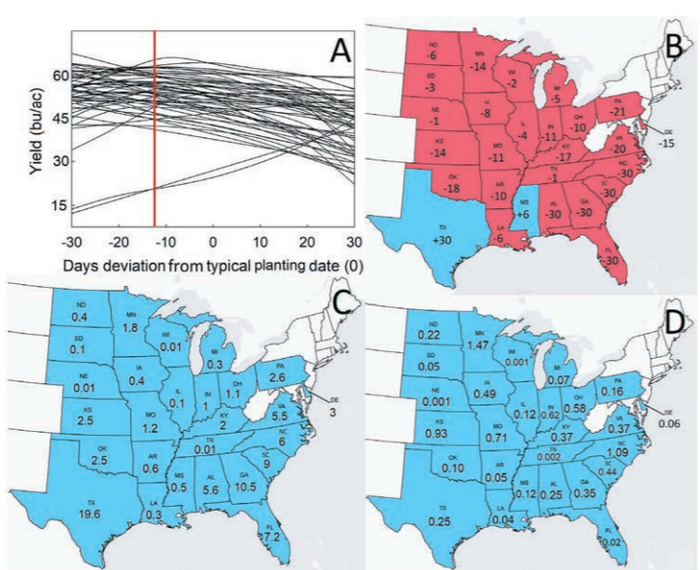
Figure 3. Ten-year average state-specific (n=27 States) effect (A) of planting date on soybean yield (bu/ac) using weather data sets that differed from the typical planting date (trials planting date set to zero) in 10-day increments (spanning a total of -30 to +30 days). The red vertical line shows the U.S.-average predicted optimum planting date difference from typical. (B) Ten-year state-specific optimum planting date difference from typical. Earlier optimum predicted planting dates (negative numbers) were identified in red-colored states, but later than typical optimum dates (positive numbers) were identified blue-colored states. (C) Simulated 10-year average yield increase (bu/ac) when using the optimum predicted planting dates in each state. (D) Simulated ten-year state-specific cumulative effect of optimum earlier planting than typical when expressed in terms of soybean producer income (in 2016 inflation-adjusted billion U.S.$).
A clear trend of increased yields due to earlier planting was observed within most states (Fig. 3 A) across the 10 years of the study. Excluding Texas and Mississippi, where later planting by 30 and 6 days, respectively, increased yield, planting 12 days earlier than what was practiced during this decade (2007-2016) across the U.S. would have resulted in a 10% greater total yield.
Our results suggest that Southeastern state producers could adjust planting dates by 30 days earlier than those typically used (Fig. 3 B). Such adjustment would have resulted in a 5.6 to 10.5 bu/ac average yield increase (Fig. 3 C). Mississippi and Texas growers have already adopted an early planting date strategy ca. 1994(Heatherly, 1999), and it appears that later planting by 5 and 30 days, respectively, from what currently is used would have increased yields from 2007–2016. In the Midwestern U.S., soybean producers in states such as Iowa and Ohio could have theoretically experienced a small yield increase (0.4 and 1.1 bu/ ac, respectively (Fig. 3 C)) during the past decade by 8 to 10 days earlier planting, respectively. This result is in agreement with recent regional estimates of early planting date effect on farmers’ fields (Mourtzinis et al., 2019). In other states with large cultivated areas, such as Nebraska, Illinois, and Wisconsin, producers appear to be already using near optimum planting dates. It has been reported that earlier planting dates resulted in a longer planting-to-first trifoliolate growth stage (V1) period but also advances V1 occurrence on a calendar date basis(Bastidas et al., 2008). This leads to earlier node accrual and floral induction which can optimize the final number of main stem nodes and result in greater yield potential (Bastidas et al., 2008).
Using state-year-specific total income data ($) and the previously calculated yield change due to planting date adjustment (Fig. 3 C), a 10-year cumulative monetary effect was estimated for each state (Fig. 3 D). A substantial monetary gain from earlier planting was estimated in most soybean producing states. Minnesota, North Carolina, and Kansas would have experienced the greatest monetary gains that could have reached ca. U.S. $0.9–1.5 billion. The gains would have been lower in Southern and Southeastern states, despite the greatest yield change due to planting date adjustment from the Northern states, mainly due to the smaller cultivated area. Overall, planting date adjustment across the continental U.S. from 2007 through 2016 would have resulted in a cumulative gain of ca. U.S. $9 billion. We note that earlier planting may be associated with an additional cost for farmers to update or add additional planting equipment. Still, because such costs can be amortized out over time, we consider our estimates as an upper bound of hypothetical monetary benefits.
Figure 4. Location-specific (n=289 locations distributed in 27 states across the U.S. – Fig 1) spring frost probability for 32, 30, 28, and 26 °F at soybean emergence (at 15 DAP) for 30 DBP to a 30-DAP date bracketing the actual planting date (set to 0). The red line shows the 20% spring frost probability threshold. The probabilities for each location were calculated using last 46 years of weather data (1981 to 2016).
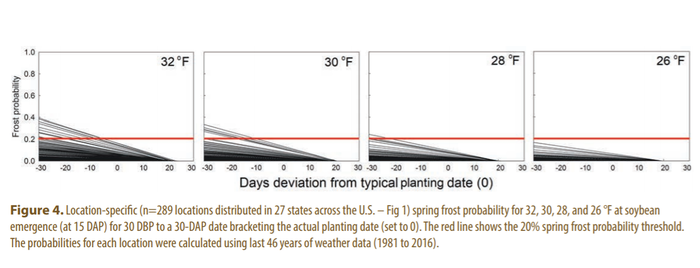
An important consideration in early planting is spring frost occurrence, which can damage or destroy the crop (but only after emergence at 15–25 DAP)(Meyer and Badaruddin, 2001). The current common recommendation to soybean producers is to plant the first field when frost probabilities are less than 20% on or after emergence. Minor frost damage on emerged seedlings may occur when temperature drops below 32 °F, but becomes more damaging when temperature drops below 28° F for prolonged periods. In Northern and Midwestern states, where the risk for early frost damage is higher, optimum planting dates were observed for up to 21 days earlier than what are typically used (Fig. 3 B). Using the 21 days earlier planting as a threshold, 2% of all 289 locations (all in North Dakota, South Dakota, and Minnesota) exceeded the 20% probability threshold for daily minimum temperatures to drop below 32 °F at emergence and only 0.3% had exceeded the 20% probability for daily minimum temperatures to drop below 30 °F (Fig. 4). In the Southeastern states, frost probabilities (Tmin<32 °F) for 30-days earlier planting was zero. Considering that climate models under different emission scenarios have projected an increase in frost-free season length until the end of the century (Walsh et al., 2014), these results suggest that frost may not be a serious issue for most regions of the continental U.S. when moving planting dates earlier into spring.
Conclusions
Global temperatures are expected to continue increasing until 2100 (IPCC, 2013). Furthermore, a 20% cumulative increase in Vpd in July in the Midwest is projected by 2040 (Lobell et al., 2014), driven by increased temperatures and reduced relative humidity. Climate simulations have also estimated up to a 30% reduction in precipitation during summer months in many U.S. regions, including the Midwest and much of the Corn Belt (Walsh et al., 2014). It is clear that soybean exhibits variable sensitivities to weather during vegetative and reproductive development (Purcell and Specht, 2004). To that end, we show here that with state-specific planting date adjustment, drought impact during sensitive developmental stages could be mitigated.
Overall, our results agree with previously reported simulated future yield trends (7– 15% increase) due to climate adaptation in wheat, rice, and maize (Challinor, et al., 2014). The results in our study complement the previously measured sensitivity of soybean-related long-term economic returns to regional climatic change (Mourtzinis et al., 2015; Specht et al., 1999) by identifying and quantifying climate changerelated yield constraints. It is evident that many progressive farmers in the NC U.S. region (e.g., NE and WI), continuously monitor and strive to plant crops earlier on an annual basis. Our results highlight the potential yield and monetary benefit that U.S. farmers can gain due to planting date adjustment by using the results we report as a point of reference of optimal planting date in each state. Lastly our findings suggest that the USDA Risk Management Agency should consider updating their antiquated earliest planting dates for replant payments to reflect current environmental and monetary factors.
Source: University of Wisconsin-Madison, which is solely responsible for the information provided and is wholly owned by the source. Informa Business Media and all its subsidiaries are not responsible for any of the content contained in this information asset.
About the Author(s)
You May Also Like




